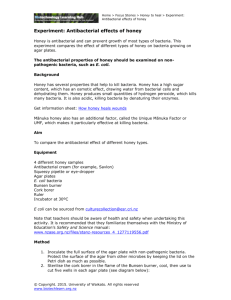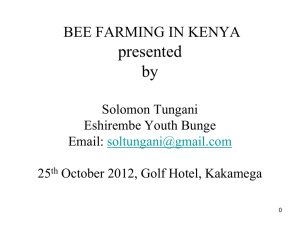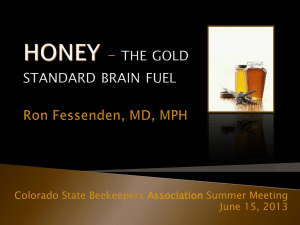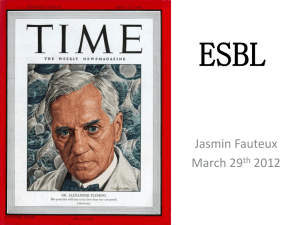Antimicrobial Effect of Honey in E. coli growth
advertisement
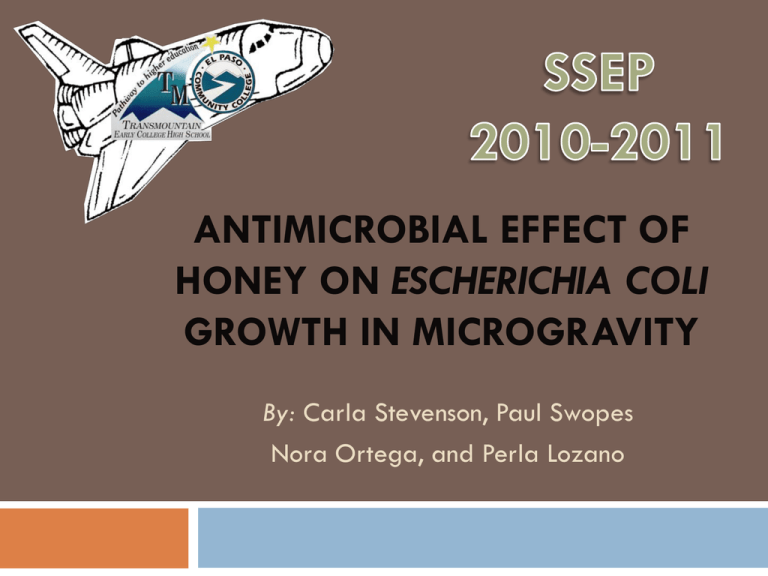
ANTIMICROBIAL EFFECT OF HONEY ON ESCHERICHIA COLI GROWTH IN MICROGRAVITY By: Carla Stevenson, Paul Swopes Nora Ortega, and Perla Lozano Honey, an Ancient Medicine Prehistoric man gathering honey. A rock painting, made around 6000 BC. La Arana shekter, Bicorp, Eastern Spain. In ancient Egypt, honey was considered "the nectar of the gods“ Evidence Treatment of different pathologies caused by bacteria with honey Growth inhibition of diarrhea-causing bacteria , including E. coli; the minimum inhibitory concentration (MIC) for E. coli was 1:8 of honey in sterile distilled water (v/v) (Adebolu, 2005) Traditional topical treatment of infected wounds (Molan, 2001) Treatment of burn wounds with honey (Adeleke et al., 2006) Growth inhibition of S. aureus, E. coli and Pseudomonas sp.; MIC (mg/ml) against E. coli was 6.25 (Al-Naama, 2009); Scientific Evidence “Antibiotic-resistant strains have been found to be as sensitive to honey as the antibiotic-sensitive strains of the same species.” (Molan, 2001) Antimicrobial Substance in Honey The osmotic effect of its high sugar content can be sufficient to inhibit microbial growth (desiccation effect). The antibacterial property of honey increases in dilution - the enzyme glucose oxidase is activated in water resulting in the production of hydrogen peroxide (H2O2), which is toxic to bacteria (Jeffrey and Echazarreta, 1996). Gravity Effect? Previous Studies: Microgravity has no effect on the growth rate of Escherichia coli cells (Gasset et al., 1994). Microgravity appears to reduce the lag period of E. coli (Thévenet et al., 1996). Final cell densities were higher in low-gravity cultures (Kacena et al., 1999) “Salmonella enterica serovar Typhimurium grown under modeled microgravity (MMG) were more virulent … compared to organisms grown under normal gravity (Nickerson et al., 2000) Our Experiment Preparation of bacteria: One colony of Escherichia coli K-12 grown on Eosin Methylene Blue (EMB) agar was placed into 9ml Miller’s LB broth; incubated at 37˚C for 24 h Cells were washed and diluted serially to adjust titer to 1.4x108 C FU/ml Our Experiment MIC determination: Three experiments were performed Concentrations of honey tested: 10%, 5%, 1%, 0.5%, 0.1%, and 0% (volume) (following Molan, 2001) Experiment 1: Stored in the dark for 48 hours at room temperature. Experiment2: Stored in the dark for 5 days at room temperature. The cells were washed and serial dilutions prepared from 10-5 to 10-8 1 ml of each dilution was plated on TSA agar to determine colony forming units (CFU) counting 2 plates / dilution Results • CFU counting gave the following results: %Honey (v) 0 (Control) 1. 2.1x108 2.2x108 1.5x108 1.4x108 1.2x108 9.2x107 2.2x108 1.8x108 4.4x107 1.3x107 4.4x107 1.6x108 CFU/ml (48hrs) 2. CFU/ ml (5 days) 0.1 0.5 1 5 10 Results 2.63 Bacteria Concentration Log10 CFU/ml 2.13 1.63 48 Hours 5 Days 1.13 0.63 0.13 control 0.10% 0.50% 1% 5% Honey Concentration (Percentage) 10% References Adebolu TT (2005). Effect of natural honey on local isolates of diarrhea causing bacteria in southwestern Nigeria. African Journal of Biotechnology 4, pp. 1172-1174. Adeleke OE, Olaitan JO, Okpekpe EI (2006). Comparative antibacterial activity of honey and gentamycin against Escherichia coli and Pseudomonas aeruginosa. Annals of Burns and Fire Disasters (ISSN 1592-9566). Al- Naama RT (2009). Evaluation of in-vitro inhibitory effect of honey on some microbial isolate. Journal of Bacteriology Research 1, pp. 064-067. Jeffrey AE, Echazarreta CM (1996). Medical uses of honey. Rev. Biomed 7: 43 – 49. Gasset G, Tixador R, Eche B, Lapchine L, Moatti N, Toorop P, Woldringh C (1994). Growth and division of Escherichia coli under microgravity conditions. Research in Microbiology 145, pp 111-12. Kacena MA, Merrell GA, Manfredi B, Smith EE, Klaus DM, Todd P (1999). Bacterial growth in space flight: logistic growth curve parameters for Escherichia coli and Bacillus subtilis. Appl Microbiol Biotechnol 51: 229-234. References cont. Nickerson CA, Ott CM, Mister SJ, Morrow BJ, Burns-Keliher L, Duane L, Pierson DL (2000). Microgravity as a Novel Environmental Signal Affecting Salmonella enterica Serovar Typhimurium Virulence. Infection and Immunity 68, p. 31473152. Thévenet D, D'ari R, Bouloc P (1996). The SIGNAL experiment in BIORACK: Escherichia coli in microgravity . Journal of Biotechnology 47,pp 89-97 Zia MA, Rahman K, Saeed MK, Andaleeb F, Rajoka MI, Sheikh MA, Khan IA,Khan AI (2007). Thermal Characterization of Purified Glucose Oxidase from A Newly Isolated Aspergillus Niger UAF-1. J Clin Biochem Nutr 41: 132–138 Benefits of Honey; Crandall Farms Honey. Retrieved from: http://www.crandallfarms.com/benefits.html THANK YOU! This project was supported in part by: Texas Space Grant Consortium Foundation for EPCC MSEIP Grant Number P120A080025 MBRS-RISE Grant Number 5R25GM060424 EPCC President’s Office The End
![Jefferson County, KY [Mission 5, Flight Experiment]](http://s2.studylib.net/store/data/005381659_1-6ff410f794c42188c46f63145dca8240-300x300.png)


